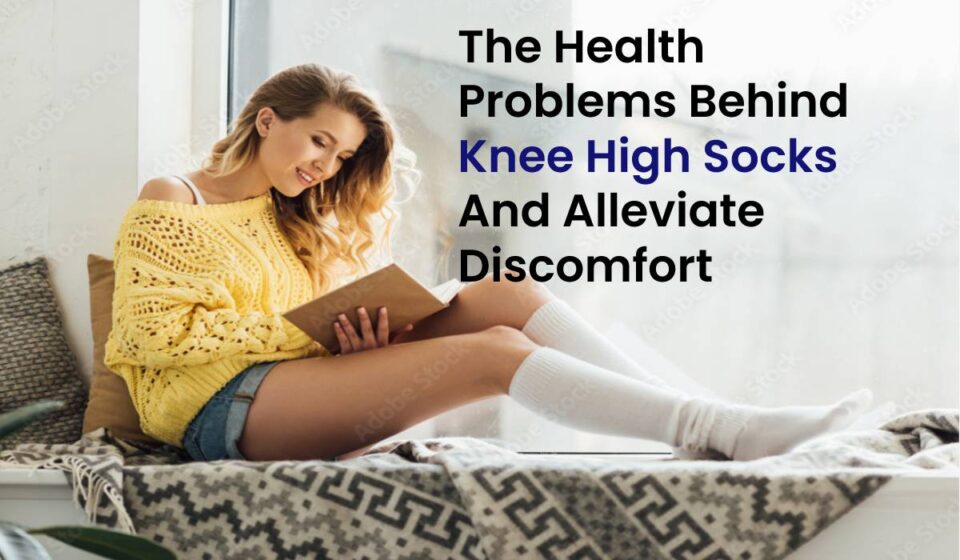Knee High Socks marks are a sign of lower leg swelling that could be due to high blood pressure. But swelling in the knees, ankles, and feet can also cause by circulatory and lymphatic problems, heart failure, kidney or liver disease, and obesity.
Table of Contents.
Amazon Store for Knee High Socks
The Clearest Sign? The marks left by Knee High Socks
If the symptoms are mild and do not occur frequently, it is not a problem, but if the inflammation is recurrent or worsens and increases, especially in the lower leg, it might be a severe health problem.
In a situation like this, you will go more than once. You wake up in the morning, choose your favorite socks, put them on, and it seems that everything fits, they fit you perfectly, and you could not be more comfortable, but as the hours go by, you start to feel uncomfortable and notice a strange sensation in your ankles and legs.
You hold the pull as best you can, and at the end of the day, you verify that your suspicions are true, you have swelling or edema in your ankles, and your socks’ mark has remained. It may seem silly or due to a simple dilation of the veins when the temperatures are higher. But if sock marks are common and occur throughout the year, you have to analyze the possible reasons.
Standing or sitting too long can cause lower leg swelling or edema, with symptoms like tight shoes and sock marks.
Also Read: 5 Benefits of Compression Stockings And Their Pros And Cons
Swelling of the Ankles is not Normal
If you consistently find that the elastics in your socks are marking your ankles, you may be retaining fluids, known as peripheral edema. The skin looks shiny and tight due to the swelling caused by the accumulation of fluids. It is commonly mild, and the swelling goes away after some time on its own.
However, cardiologists feel that it should evaluate if it becomes a common problem. Even if it happens occasionally, it will not hurt to consult with your GP. And it is that the marks on the socks can indicate high blood pressure. It would be one of the reasons why the elastic impact remains in your socks.
Also, high blood pressure can accompany diastolic dysfunction, a heart failure that makes it difficult for the heart to pump blood throughout the body. The body responds to insufficient blood flow by retaining fluid deposited in the lower parts of the body, usually the legs and feet.
Swelling, therefore, appears when excess fluid accumulates in the lower legs. Edema is usually not painful on its own, but wearing shoes and socks can be uncomfortable if your legs and feet will swell.
“Sodium retention causes high blood pressure and fluid retention, which is the most common reason why the lower legs swell,” they explain from the Spanish Society of Cardiology (SEC).
Also Read: 9 TIPS TO AVOID FOOT PROBLEMS WITH KNEE HIGH BOOTS
Using proper compression measures can alleviate discomfort for Knee High Socks
Venous insufficiency is another cardiovascular problem that can cause swelling. It occurs when the veins in the legs do not allow blood to return to the heart. When vein valves don’t work well, blood can pool in the legs and cause painful swelling. This condition is also known to cause varicose veins.
Kidney and liver problems and certain medications can also cause lower leg swelling. Hence, it is essential to go to the doctor to perform the necessary tests to find out what is causing the problem.
If it’s Fluid Retention
When there is no underlying disease like the ones we have mentioned, the symptoms of fluid retention are mainly due to an excess of capillary permeability. The fluids leak through the blood capillaries and accumulate in the tissues, generating these annoying retention problems.
It is a prevalent disorder, especially among women, causing excessive fluids in the tissues.
Also Read: Get Healthy Stay Healthy while Recovering From An Injury
The Best Way to Detect It
In addition to swelling in the legs and ankles, the symptoms of edema are unexplained weight gain, increased abdominal perimeter, and the presence of fovea (if we press the skin firmly with the finger, we notice a sag that remains for some minutes or seconds after we have removed the finger).
To know if you have fluid retention, you should examine your hands, legs, ankles, and feet for signs of inflammation; see if your rings, watches, or bracelets are tighter than before; Check if your stockings or socks leave a mark around your legs, and press any swollen areas with your thumb and lift it. If the effect is visible, you likely suffer from fluid retention. are the two most straightforward ways
Also Read: Yellow Fungus: Symptoms, Risks, Causes, Treatment by Experts
The Most Frequent Signs of Knee High Socks:
- Ankle swelling: marks from socks appear, ankles lose definition, bone reliefs are not visible, etc.
2. Heaviness of legs: feeling of tiredness and discomfort in the entire lower limb, as if we could handle them as if they were not pulling us and we had to pull them. Spongy skin, especially at the level of the knees.
3. Hand congestion: the hands swell, the fingers are dull, it is difficult to remove the rings. Cramps, cramping, and tingling may appear at the tips of the fingers.
4. Puffy eyes: heaviness of the eyes with an accumulation of periorbital fluid, causing an asthenic and fatigued appearance (it is frequent in the morning or with fatigue at the end of the day).
5. Abdominal distention: the belly swells throughout the day without being directly related to food intake. It can be more commonly alter in the premenstrual phase.
6. Breast tenderness: considerable increase in breast size and devotion to the touch of the nipples. Often, too, it appears in the premenstrual phase or after ovulation.


